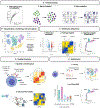From bench to bedside: Single-cell analysis for cancer immunotherapy
- PMID: 34329587
- PMCID: PMC8406623
- DOI: 10.1016/j.ccell.2021.07.004
From bench to bedside: Single-cell analysis for cancer immunotherapy
Abstract
Single-cell technologies are emerging as powerful tools for cancer research. These technologies characterize the molecular state of each cell within a tumor, enabling new exploration of tumor heterogeneity, microenvironment cell-type composition, and cell state transitions that affect therapeutic response, particularly in the context of immunotherapy. Analyzing clinical samples has great promise for precision medicine but is technically challenging. Successfully identifying predictors of response requires well-coordinated, multi-disciplinary teams to ensure adequate sample processing for high-quality data generation and computational analysis for data interpretation. Here, we review current approaches to sample processing and computational analysis regarding their application to translational cancer immunotherapy research.
Keywords: computational biology; single-cell proteomics; single-cell transcriptomics; spatial proteomics; spatial transcriptomics; translational medicine; tumor immunology.
Copyright © 2021 Elsevier Inc. All rights reserved.
Conflict of interest statement
Declaration of interests W.J.H. is a coinventor of patents with potential for receiving royalties from Rodeo Therapeutics/Amgen, is a consultant for Exelixis, and receives research funding from Sanofi. E.M.J. is a paid consultant for Adaptive Biotech, CSTONE, Achilles, DragonFly, and Genocea; receives funding from the Lustgarten Foundation and Bristol Myer Squibb; is the chief medical advisor for Lustgarten, and an SAB advisor to the Parker Institute for Cancer Immunotherapy (PICI) and for the C3 Cancer Institute. E.J.F. is a member of the Scientific Advisory Board of Vioscera Therapeutics/ResistanceBio. All other authors have nothing to disclose.
Figures



References
-
- Aoki T, Chong LC, Takata K, Milne K, Hav M, Colombo A, Chavez EA, Nissen M, Wang X, Miyata-Takata T, et al. (2020). Single-Cell Transcriptome Analysis Reveals Disease-Defining T-cell Subsets in the Tumor Microenvironment of Classic Hodgkin Lymphoma. Cancer Discov 10, 406–421. - PubMed
Publication types
MeSH terms
Grants and funding
LinkOut - more resources
Full Text Sources
Other Literature Sources
Medical

